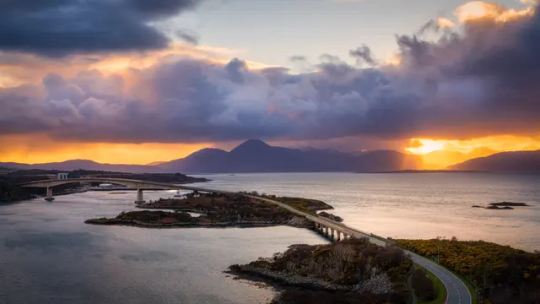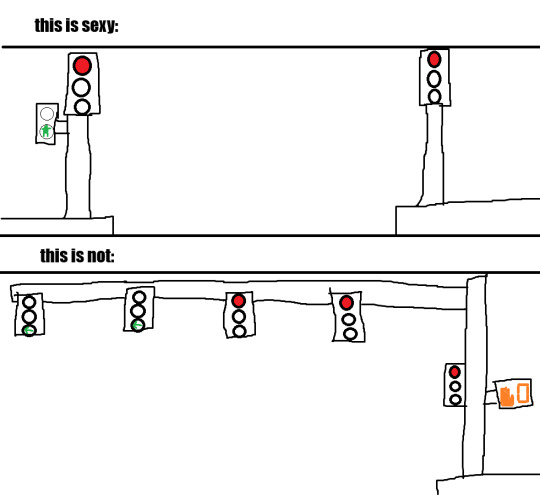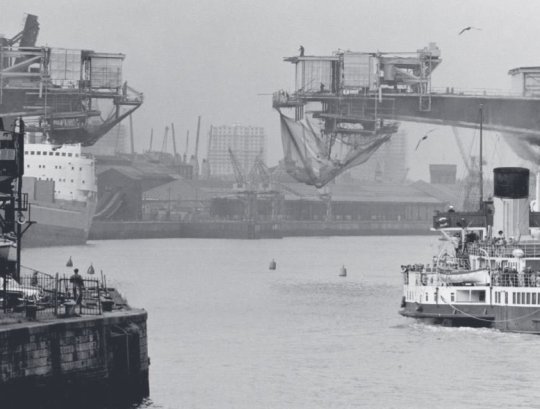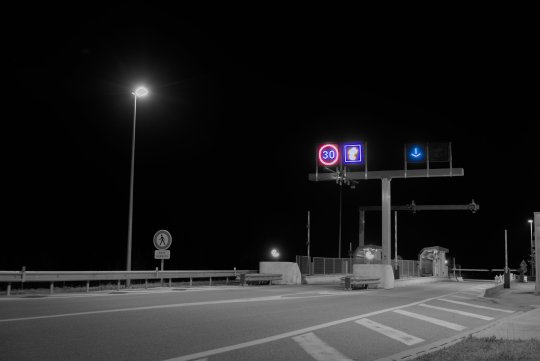#traffic infrastructure
Explore tagged Tumblr posts
Text










On October 16th 1995 the Bridge to the Isle of Skye opened.
Prior to the opening of the bridge the main route to Skye was by the ferry between the 2 villages Kyle of Lochalsh and Kyleakin. The ferry service was operated by Caledonian MacBrayne the short route of about 500m took 5min, at peak times there was often queues to use the ferry.
The bridge construction started in 1992 built by the Scottish company Miller, but designed by a German engineering company DYWIDAG Systems International in collaboration with civil engineering firm Arup.
The main bridge is a concrete arch, supported by two piers. This connect Skye to the small island called Eilean Bàn, the rest of the bridge is level across to the mainland. The total distance across is 1.5 miles. The main arch is about 35m high with around 30m clearance for boats on high tide.
Eilean Bàn (White Island) is the small island upon which the main arch of the bridge rests.
The island has a 21m high lighthouse just below the bridge arch. The lighthouse keepers (before automation in the 1960s) stayed in the cottages on the Island. These cottages where then purchased by Gavin Maxwell who is best remembered for is work with otters. Maxwell did many interesting things including writing wildlife books, his most famous is called "The Ring of Bright Water”.
These days the island is a wildlife reserve being managed by the Bright Water Trust. One of the cottages is now the Maxwell museum. This is a reconstruction of Maxwell’s 40ft living room, containing original artefacts, recreated by Virginia Mckenna of the Born Free foundation.
Most people wanted the bridge, but the way in which it was funded was conversional. Rather than the UK government paying for it, the government allowed it to be privately funded. Then granted a licence for the private company to charge tolls. It was said to be the most expensive road bridge in Europe.
This clearly upset many people. Locals on Skye setup a campaign group called SKAT (Skye and Kyle Against Tolls). After years of campaigning, legal challenges and then the setup of the new Scottish parliament in 1999 the leading political parties made it a priority to have the tolls abolished.
On the 21st of December 2004 the bridge was purchased by the Scottish Government and made free to cross.
41 notes
·
View notes
Text
Medium voltage support insulator manufacturers in India | radiantenterprises
Elevate your electrical solutions with Radiant Enterprises, a top name among customised insulator manufacturers in India. Specializing in high-quality epoxy insulators, we cater to the specific needs of your projects with precision and expertise. As leading medium voltage support insulator manufacturers in India, we provide durable and reliable products that meet the highest industry standards.
Trust Radiant Enterprises for innovative and customized insulator solutions designed to enhance the performance and safety of your electrical systems.
#Epoxy insulator#Customised insulator manufacturers in India#Medium voltage support insulator manufacturers in India#epoxy bushing#epoxy insulator#epoxy resin#electrical company#electrical engineering#electrical industry#fuse cutouts#smart grid sensor#rail insulator#railway technology companies#train operating companies#locomotive#tramways#metro systems#traffic infrastructure#third rail#cable connector#innovative insulators#export quality
4 notes
·
View notes
Text
demigods are a bunch of preteens with adhd who climb a wall of lava for fun over the summer. their sense of danger is very, very skewed
my point is, there should be more instance of demigods doing stupid shit while out in the mortal world (on non-quest instances)
#demigods climbing random infrastructure without gear because they got dared to#“you’re not game to climb the water tower” they say like it’s supposed to be challenging#demigods running into incoming traffic without a care in the world#after the chariot races demigods find that they are desensitized to the dangers of speeding vehicles#percy jackson#pjo#pjo headcanon#camp half blood#demigods are completely insane and it should be acknowledged more often#children of hephaestus blowing shit up in science class#the entire class panics while they’re just kind of disappointed their project got destroyed
129 notes
·
View notes
Text
bought a book abt traffic theory today yippee!!!!!
#i saw one (1) tedtalk abt optimising traffic infrastructure almost 10 years ago and i havent been the same since#helena talks to the void#twas “free” bc of my waterstones rewards card too
10 notes
·
View notes
Text

#traffic lights#traffic control#pedestrian infrastructure#car infrastructure#europe vs. america#196#literally 19684#r196#r/196#city planning
73 notes
·
View notes
Text

There aren't too many freeways around here; It seems that people decided long ago to design their life not around commuting...
This is the main freeway going to the airport - and to Sweden...
#københavn#copenhagen#ørestad#overpass#trafficblr#freeway#traffic life#commuting#infrastructure#transportation#kastrup
5 notes
·
View notes
Text
they dont tell u the hardest part about going from international schools to american schools is not culture shock but spelling words like Color and neighbor without the letter U because they teach you the british way everywhere else…. i still find myself making the mistake. the words just look so barren without U in them. and you need to decide which country you dislike more
#my rambles#american infrastructure is almost enough to get me to hate here more#bangkok should have beena miserable city but getting around there was still nicer because it had a rlly good mrt system#and traffic was always too congested for pedestrians to get hit by cars#it was mostly motorcycles 💀#But#you could walk most places and be fine#no highways going through shopping centers n shit#at least that was my perception
10 notes
·
View notes
Text





On June 26th 1970 The Kingston Bridge, carrying the M8 motorway over the River Clyde in Glasgow opened.
It might not have the global fame of San Francisco’s Golden Gate Bridge, the impressive backdrop of Sydney’s Harbour Bridge or the history of London’s Tower Bridgee, but Glasgow’s bustling Kingston Bridge, which celebrates its 54th birthday today, is every bit as iconic It was officially opened on June 26th, 1970, by the Queen Mother.
The 52,000-ton structure took three years to build and cost about £11million – the equivalent of more than £180million today. When construction began in May 1967, it was the most expensive road project yet undertaken in Glasgow.
The bridge opening marked a massive reduction of traffic travelling through Glasgow, city centre numbers dropped by a massive 75%!
The Kingston Bridge is 270m long, over 40m wide and crosses the River Clyde at a maximum height of almost 20m.
Today, the bridge carries over 150,000 vehicles a day and is one of the busiest road bridges in Europe. Currently there are moves to have the bridge listed as a structure of historic and architectural interest.
48 notes
·
View notes
Text
Cybersecurity in Power Systems: Safeguarding Transmission and Distribution Infrastructure
Introduction:
In an era dominated by technology, the power industry is undergoing a transformation, with the integration of smart grids and digital solutions becoming increasingly prevalent. However, this digital evolution brings with it a new set of challenges, particularly in the realm of cybersecurity. Power systems, including transmission and distribution infrastructure, are critical components of our modern society, making them prime targets for cyber threats. In this blog post, we will delve into the importance of cybersecurity in power systems and explore measures to safeguard transmission and distribution infrastructure.

Understanding the Landscape:
Power systems, encompassing transmission and distribution, are the backbone of any nation's infrastructure. As these systems become more interconnected and reliant on digital technologies, the vulnerability to cyber threats escalates. Transmission and distribution manufacturers in India are at the forefront of adopting innovative solutions to enhance the efficiency of power systems. However, with this increased connectivity comes the imperative need to fortify these systems against cyber attacks.
The Role of Cybersecurity in Power Systems:
Protecting Critical Infrastructure:
Cybersecurity plays a pivotal role in protecting critical infrastructure, especially in the power sector. Transmission and distribution manufacturers in India are recognizing the significance of robust cybersecurity measures to safeguard their equipment and networks.
Securing Outdoor Support Insulators:
Outdoor support insulators are crucial components in power systems, providing structural support and insulation. Cyber threats targeting these insulators could compromise the integrity of the entire power grid. Implementing cybersecurity protocols ensures the resilience of these components against potential attacks.
High Voltage Primary Bushing Outdoor Manufacturers in India:
Manufacturers producing high voltage primary bushings outdoors are well-aware of the challenges posed by cyber threats. Implementing stringent cybersecurity measures is imperative to prevent unauthorized access and manipulation of these critical components.
Addressing Vulnerabilities in Fuse Cutouts:
Fuse cutouts are essential for protecting power distribution systems from overcurrents. However, these components are susceptible to cyber threats that could disrupt their functionality. Cybersecurity measures are crucial in identifying and addressing vulnerabilities in fuse cutouts.
Cyber Threats in Power Systems:
Malware and Ransomware Attacks:
Malicious software and ransomware attacks pose a significant threat to power systems. These attacks can disrupt operations, compromise sensitive data, and demand ransom payments. Implementing robust cybersecurity measures is essential to mitigate the risk of malware and ransomware infiltrations.
Phishing and Social Engineering:
Phishing attacks and social engineering tactics target human vulnerabilities within organizations. Employees in transmission and distribution manufacturers in India must be educated on recognizing and avoiding these cyber threats to prevent unauthorized access to critical systems.
Insider Threats:
Insider threats, whether intentional or unintentional, can pose a severe risk to power systems. Establishing comprehensive access controls, monitoring systems, and conducting regular employee training can help mitigate the potential impact of insider threats.
Safeguarding Strategies:
Network Segmentation:
Implementing network segmentation is crucial to isolate and contain cyber threats. This strategy ensures that even if one part of the network is compromised, the entire system remains secure.
Regular Security Audits:
Conducting regular security audits is essential for identifying vulnerabilities and weaknesses in power systems. Transmission and distribution manufacturers in India should prioritize periodic assessments to stay ahead of evolving cyber threats.
Employee Training Programs:
Employees play a crucial role in cybersecurity. Training programs should focus on raising awareness about potential threats, recognizing phishing attempts, and promoting a security-conscious culture within the organization.
Advanced Authentication Protocols:
Implementing advanced authentication protocols, such as multi-factor authentication, adds an extra layer of security to prevent unauthorized access to critical systems.
Conclusion:
As power systems evolve with technological advancements, the need for robust cybersecurity measures becomes paramount. Transmission and distribution manufacturers in India must prioritize safeguarding their infrastructure against cyber threats to ensure the continuous and reliable delivery of power. From outdoor support insulators to high voltage primary bushings outdoors and fuse cutouts, every component plays a critical role in the functioning of power systems and requires protection from potential cyber attacks.
In the face of evolving cyber threats, a proactive approach to cybersecurity is the key to resilience. By adopting advanced cybersecurity measures and staying abreast of the latest developments in the field, Radiant Enterprises and other stakeholders in the power industry can fortify their transmission and distribution infrastructure, contributing to a secure and sustainable energy future.
#Transmission and Distribution Manufacturers in India#Outdoor Support Insulator#High Voltage Primary Bushing Outdoor Manufacturers in India#Fuse Cutouts#epoxy insulator#epoxy bushing#electricity#fuse cutouts#smart grid sensor#railway technology companies#train operating companies#locomotive#tramways#metro systems#traffic infrastructure
6 notes
·
View notes
Text
The 401 highway in Canada has the most traffic out of any road or highway in all of north America.
Because of this traffic, the average speed can drop to a stand still.
If Canada had high speed rail that took a similar route, it would be abled to transport people from different cities to Toronto's city center over 4 times faster.
The amount of cars this would take off the road would significantly reduce traffic, which would also make driving safer and faster.
The amount of time it takes to drive from Toronto to Vancouver with little to no traffic would be 41 hours of driving. If there was a cross country high speed railway that time could be cut down to less than 10 hours using the fastest German trains.
The upkeep costs for rail compared to that of highways are also much lower, and with bringing less cars into a city, it would need less subsidized parking lots which don't pay real estate tax, nor do they make room for businesses or housing.
#canada#high speed rail#trans canada rail#canadian railway#GO train#via rail#economics#infrastructure#traffic#toronto#Vancouver#highway 401#401 highway#union station#urban planning#urbanist#urbanist design#car centric design
26 notes
·
View notes
Text
While I don't fully agree with the all of the whole FuckCars movement's positions I have to admit that they have really made me question and reconsider my political views. For example, I used to think the voting age should be 18 because minors are less capable of forming opinions based on nuanced thought, but after learning that "It's not fair that I have to look both ways before crossing the street, the government should just make cars illegal!" is a position that will not get you laughed out of the room in certain circles, I realized that yeah actually you could probably lower it to 3 and it would make zero difference to the quality of political discourse
#discourse#satire#disclaimer: we need to improve public transit and pedestrian and bike infrastructure#especially in the US#and there are a lot of locations where we need to slow traffic down to achieve this#but jesus h christ some of your takes#I just saw somebody literally going 'I should not need to pay attention to my surroundings to be safe as a pedestrian'#please for the love of fuck stop saying shit that's incredibly blatantly not viable to implement#this is literally toddler throwing a temper tantrum being told that cars cant instantly stop or go around them level takes#and no 'but if they can't stop without hitting me if I randomly walk out into traffic the speed is too high#just make the speed limit 2 mph' does not count as nuanced
8 notes
·
View notes
Text

#fujifilm#fujifilm xt20#urban photography#photography#infrastructure#traffic sign#transportation#traffic signal#toll booth#tollgate#road infrastructure#road signs#night photography
19 notes
·
View notes
Text
the high holidays are still one of those events that I don't know what to "do with", personally speaking, so it feels like every year during them I end up doing the religious equivalent of throwing spaghetti at the wall and seeing what sticks
this year we're apparently starting with "judgement in the way of discernment rather than punishment; the responsibility of making decisions that will affect thousands of people for decades to come, and the weight of holding all the disparate needs and evidence for judging what the right course of action should be?" and also, "applicability of the Akedah wrt climate change? discuss."
#is that anything. am I just anxious about grad school. maybe both.#oh also the new verse that's gotten copypasta'd into unetanah tokef for me since last year#to the effect of ''who by infrastructurally-preventable traffic violence“ 🫥#....on a different note bc I'm a dingus who forgot to get fruit I suppose I'll just have to do with something else sweet until tomorrow#like mochi. or a doughnut.#content is for other people#religionblogging
9 notes
·
View notes
Text
cats are gonna make an appearance in downtown miami tonight at E11even... oh start praying for the folks deciding to club on a wednesday in fuckass downtown
#txt#theres so much construction in that area because of the whole miami bridge project nonsense#and if youre coming off the 395 whether north or south theres only a 1 lane exit#oh kitty cats please dont break that place#AND PARKINGS SHIT BECAUSE OF THE TRIPLE A. BAYSIDE. ADRIENNE ARTS AND THE FROST ARE ALL THERE TAKING UP SPACE. PLEASE PRAY FOR DOWNTOWN.#its just near a high traffic area because infrastructure is shit and thats where the transportation hubs are
2 notes
·
View notes
Text
Oh Honda Civic I've been stuck behind in stand still traffic for the last hour that I've formed a parasocial bond with, we're really in it now
9 notes
·
View notes
